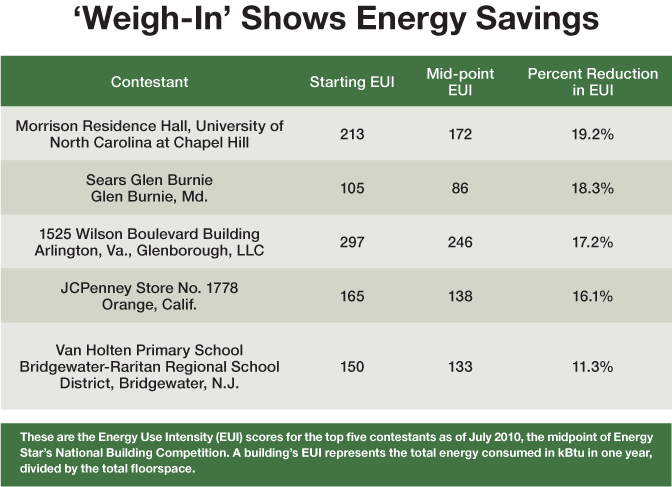Common Sense Strategies for Energy Efficiency
They say the key to lasting weight loss is going slow and steady, progressively adopting small, common sense strategies to drive the scale down. Turns out whittling down a building's energy waste works much the same way.
Taking its lead from the popular reality TV show, The Biggest Loser, Energy Star's National Building Competition pits buildings across the country against each other to see which can achieve the largest percentage drop in energy use intensity (EUI) over a 12 month period. A building's EUI represents the total energy consumed in kBtu in one year, divided by the total floorspace.
The midpoint weigh in results are in, and the leaders of the pack are achieving big goals with tried and true everyday initiatives that any facility can adopt. That's to say their double-digit results are not based on special measures undertaken just for the contest; many initiatives were already in place before the contest was even announced.
From more than 200 applicants for the competition, Energy Star selected 14 buildings across a range of facility types, locations and budgets, and in different stages of progress in addressing their energy use.
"We chose buildings of all shapes and sizes," says Lauren Pitcher, communications specialist with EPA Energy Star. "Some had rigorous energy management programs already in place. Some did not. It will provide a good road map for the nation's buildings."
The contest, which was announced in January 2010, covers metered energy data from Sept. 1, 2009 to Aug. 31, 2010. To participate, the buildings had to have their energy data entered into Portfolio Manager, the online energy benchmarking tool from Energy Star.
Energy Star estimates that about 30 percent of energy consumed by buildings is due to inefficiencies, so a lot of gains can be made by tightening operational and maintenance procedures, as well as changing the behavior of occupants. While that's not to say that's all a building can lose, it's what is realistic through easy measures. At the midpoint, several contestants were well on their way. (For the stats on the five leaders so far, see the chart below.)
Common Sense Strategies
"This is not rocket science," says Rob Keller, energy and engineering director at JCPenney. "We did not do the rocket science. Just the basics."
JCPenney's Orange, Calif., store No. 1778 is currently fourth in the standings, with an EUI reduction of 16.1 percent. For the 100-year-old retailer with a portfolio averaging 25 years in facility age, addressing the fundamentals has been challenging but rewarding. Companywide, energy efficiency has long been on the radar and just this spring an initiative to reduce energy use 20 percent per gross square foot by 2015 was announced.
For Keller, the most effective strategy in reducing energy use has been gaining access to real-time data. The store participates in the company's Advanced Energy Management (AEM) program and as part of that had an interval data recorder installed late last summer. This allows next-day availability of energy data, instead of having to wait for the monthly bill. With a monthly bill, he says, you have no idea when and where you used the energy. "Having that energy data in a more timely format is huge," Keller says. "You can correct it the next day."
Interval data is reported in year-prior and current-year energy profiles on a Monday-to-Monday basis. The data is reported in kWh and in dollars so it has meaning for its audience, Keller says.
Using the AEM program, the store manager discovered that the lights weren't going off at night Ð the controller installed in 1977 had failed. New controls mean the lights can now be scheduled.
Another leading contestant that is making the little things count is Van Holten Primary School in Bridgewater, N.J. With an EUI reduction of 11.3 percent at mid-point, they're just behind JCPenney in the standings. But it takes knowing where they started to appreciate just how far they've come.
A little over three years ago, Van Holten's Energy Star score was 17. The Energy Star score is generated by Portfolio Manager and compares a facility to its peers. A score of 17 meant that 83 percent of other similar facilities were more energy efficient than Van Holten.
About three years ago, the Bridgewater-Raritan Regional School District started working with a third-party energy management consultant to adopt simple strategies to save on energy. Van Holten's current Energy Star score is in the mid 50s and they've set their sights on getting the Energy Star label, requiring a score of at least 75.
But getting the label hasn't been the motivator. They simply try to do better each year, a little bit at a time.
"We look at it as more of a short term thing of just trying to keep improving," says George Rauh, principal at Van Holten. "I think once people saw success, the success bred more success."
Van Holten did recently undergo a retrofit of the HVAC system, but historically their gains have come from small tasks: turning lights off, turning computers off, etc. "It's just about doing the little things and being a stickler about doing them," says Rauh.
A group of students — the SEE (Schools for Energy Efficiency) Squad — helps with that "stickler" effect. They go around and if they see something left on in a vacant room, they leave an "oops" sticker. Rauh admits that he got an oops sticker once, and from then on, he has made sure his lights and computer are off when he leaves his office.

Related Topics:













